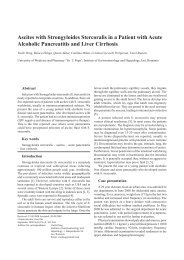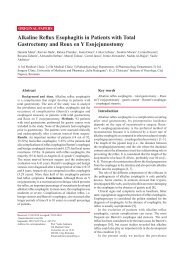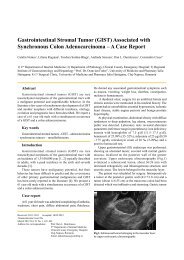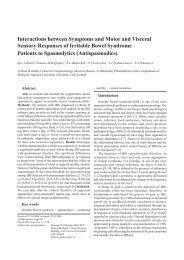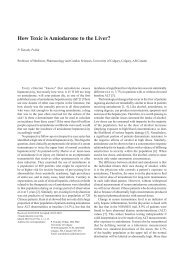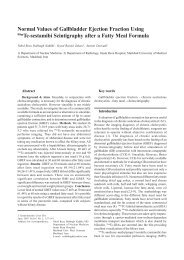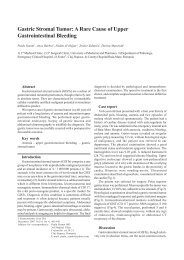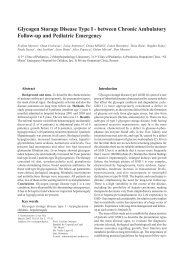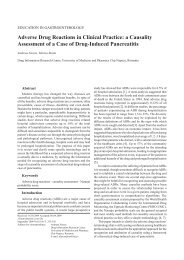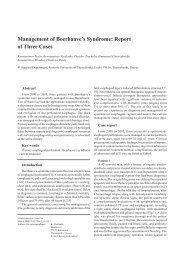Blue Rubber Bleb Nevus Syndrome - Journal of Gastrointestinal and ...
Blue Rubber Bleb Nevus Syndrome - Journal of Gastrointestinal and ...
Blue Rubber Bleb Nevus Syndrome - Journal of Gastrointestinal and ...
Create successful ePaper yourself
Turn your PDF publications into a flip-book with our unique Google optimized e-Paper software.
238<br />
since he was 4 year old <strong>and</strong> a history <strong>of</strong> removal <strong>of</strong> gastric<br />
vascular tumors. There was no family history <strong>of</strong> the disease.<br />
At the physical examination, the patient was extremely<br />
pale, tachycardic <strong>and</strong> presented a nodule <strong>of</strong> 2 cm <strong>of</strong> diameter<br />
at the sole <strong>of</strong> the left foot, in which small caliber vessels<br />
could be visualized, <strong>and</strong> another similar on the first left toe<br />
(Fig.1). The same vascular protrusions were found in the<br />
mouth (Fig.2).<br />
The blood cell count at admission revealed: Hb= 9.7 g/<br />
dl, Ht = 28 %, microcytosis , hypochromia. The leukocyte<br />
<strong>and</strong> platelet counts were normal. Before receiving a<br />
transfusion <strong>of</strong> erythrocytes, blood samples were collected<br />
<strong>and</strong> an iron serum level <strong>of</strong> 8 µmol/l was found.<br />
The upper gastrointestinal endoscopy revealed four<br />
small wine – color lesions in the stomach <strong>and</strong> a larger one in<br />
the antrum (Figs.3,4).<br />
The colonoscopy showed wine-color vascular lesions<br />
<strong>of</strong> different sizes (the largest vascular tumor was about 1.5<br />
cm) in the rectum, sigmoid, descendent <strong>and</strong> cecum, with<br />
raised , irregular surfaces, which were brittle in contact with<br />
the endoscope. In the cecum, near the ileo–cecal valve there<br />
was another larger lesion , measuring approximately 2 cm at<br />
its widest diameter (Figs.5-7).<br />
The diagnostic search for a clinical condition presenting<br />
the association <strong>of</strong> vascular tumors <strong>of</strong> the skin with severe<br />
iron deficiency anemia, the history <strong>of</strong> more than 20 episodes<br />
<strong>of</strong> melena <strong>and</strong> hematemesis, led the authors to consider the<br />
diagnosis <strong>of</strong> BRBNS.<br />
The investigation <strong>of</strong> systemic involvement was<br />
completed with an abdominal ultrasound examination, skull<br />
tomography, retinoscopy. All were normal.<br />
The therapeutic decision was difficult <strong>and</strong> was the result<br />
<strong>of</strong> working together with the surgical team. Our therapeutical<br />
schedule was: supportive therapy with octreotide to decrease<br />
blood flow, proton pump inhibitors, iron replacement <strong>and</strong><br />
blood transfusions, endoscopic sclerotherapy <strong>and</strong> argon<br />
plasma coagulation <strong>of</strong> the vascular tumors.<br />
Unfortunately, we did not have a good compliance from<br />
the patient’s family <strong>and</strong> the patient left the hospital after<br />
two sessions <strong>of</strong> sclerotherapy.<br />
Discussion<br />
BRBNS is a rare disorder with only approximately 200<br />
cases reported in the world literature. Most cases are sporadic<br />
but autosomal dominant inheritance has been reported. The<br />
disorder has not been localized to a specific chromosome or<br />
gene defect.<br />
The mortality <strong>and</strong> morbidity associated with BRBNS<br />
depend on the extent <strong>of</strong> visceral organ involvement. Most<br />
patients have a normal life span. No malignant<br />
transformation <strong>of</strong> cutaneous or visceral lesions has been<br />
reported. Some patients may have severe hemorrhage from<br />
the GI tract, sometimes fatal. Serial transfusions <strong>and</strong> periodic<br />
surveillance can improve the outcome <strong>of</strong> the disease.<br />
Lesions involving bones <strong>and</strong> joints can cause pr<strong>of</strong>ound<br />
Fig.1 Vascular protrusion on the left foot.<br />
Dobru et al<br />
discomfort <strong>and</strong> loss <strong>of</strong> function, requiring amputation in<br />
some cases. Central nervous system involvement is rare,<br />
but might be fatal (4-7).<br />
The syndrome has been reported in all races, although<br />
Caucasians appear to be most frequently affected. The<br />
disease affects males <strong>and</strong> females equally .<br />
In BRBNS, the skin <strong>and</strong> GI system are most frequently<br />
involved, with multiple vascular blebs or nodules. However,<br />
case reports have demonstrated that the central nervous<br />
system, thyroid, parotid, eyes, oral cavity, musculoskeletal<br />
system, lungs, kidney, liver, spleen <strong>and</strong> bladder may also be<br />
affected (2-5).<br />
Cutaneous lesions are <strong>of</strong>ten apparent at birth or manifest<br />
in early childhood, but late onset, beyond midlife has also<br />
been reported. GI involvement usually becomes evident<br />
during early adulthood (2,3,8 ). Histopatologic examination<br />
<strong>of</strong> lesions reveals blood-filled ectatic vessels, lined by a<br />
single layer <strong>of</strong> endothelial cells, with surrounding thin<br />
connective tissue. Dystrophic calcification may be present<br />
(4-6).<br />
Symptoms <strong>and</strong> signs vary depending on the organ<br />
system involved. Patients may report fatigue from occult<br />
blood loss. Hematemesis, melena or rectal bleeding may<br />
prompt emergency presentation, <strong>and</strong> this was also the<br />
presentation <strong>of</strong> the disease in our patient. When bones are<br />
involved, there may be complaints <strong>of</strong> joint pain or impaired<br />
ambulation. Extracutaneous lesions also may result in<br />
epistaxis, hemoptysis, hematuria or menorrhagia.<br />
Physical findings reveal either cutaneous or<br />
extracutaneous manifestations. Skin lesions are usually<br />
highly characteristic, as multiple, protuberant dark blue<br />
vascular tumors, a few millimeters to several centimeters in<br />
diameter. They have the look <strong>and</strong> feel <strong>of</strong> a rubber nipple.<br />
Lesions may be few in number or range into hundreds. The<br />
lesions are principally located on the upper limbs, trunk,<br />
perineum, but they may occur anywhere.<br />
In the GI tract, vascular malformations may occur<br />
anywhere from oral to anal mucosa, but predominate in the<br />
small bowel. In contrast to the skin lesions, the GI lesions<br />
<strong>of</strong>ten bleed. They may spontaneously rupture causing acute




